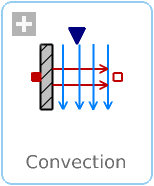WOLFRAM SYSTEM MODELER
ConvectionLumped thermal element for heat convection (Q_flow = Gc*dT) |
|
Wolfram Language

SystemModel["Modelica.Thermal.HeatTransfer.Components.Convection"]

Information
This information is part of the Modelica Standard Library maintained by the Modelica Association.
This is a model of linear heat convection, e.g., the heat transfer between a plate and the surrounding air; see also: ConvectiveResistor. It may be used for complicated solid geometries and fluid flow over the solid by determining the convective thermal conductance Gc by measurements. The basic constitutive equation for convection is
Q_flow = Gc*(solid.T - fluid.T); Q_flow: Heat flow rate from connector 'solid' (e.g., a plate) to connector 'fluid' (e.g., the surrounding air)
Gc = G.signal[1] is an input signal to the component, since Gc is nearly never constant in practice. For example, Gc may be a function of the speed of a cooling fan. For simple situations, Gc may be calculated according to
Gc = A*h A: Convection area (e.g., perimeter*length of a box) h: Heat transfer coefficient
where the heat transfer coefficient h is calculated from properties of the fluid flowing over the solid. Examples:
Machines cooled by air (empirical, very rough approximation according to [Fischer2017, p. 452]:
h = 7.8*v^0.78 [W/(m2.K)] (forced convection) = 12 [W/(m2.K)] (free convection) where v: Air velocity in [m/s]
Laminar flow with constant velocity of a fluid along a flat plate where the heat flow rate from the plate to the fluid (= solid.Q_flow) is kept constant (according to [Holman2010, p.265]):
h = Nu*k/x; Nu = 0.453*Re^(1/2)*Pr^(1/3); where h : Heat transfer coefficient Nu : = h*x/k (Nusselt number) Re : = v*x*rho/mu (Reynolds number) Pr : = cp*mu/k (Prandtl number) v : Absolute velocity of fluid x : distance from leading edge of flat plate rho: density of fluid (material constant mu : dynamic viscosity of fluid (material constant) cp : specific heat capacity of fluid (material constant) k : thermal conductivity of fluid (material constant) and the equation for h holds, provided Re < 5e5 and 0.6 < Pr < 50
Connectors (3)
| Gc |
Type: RealInput Description: Signal representing the convective thermal conductance in [W/K] |
|
|---|---|---|
| solid |
Type: HeatPort_a Description: Thermal port for 1-dim. heat transfer (filled rectangular icon) |
|
| fluid |
Type: HeatPort_b Description: Thermal port for 1-dim. heat transfer (unfilled rectangular icon) |
Used in Examples (10)
|
Modelica.Mechanics.MultiBody.Examples.Elementary Demonstrate the modeling of heat losses |
|
|
Modelica.Mechanics.Rotational.Examples Demonstrate the modeling of heat losses |
|
|
Modelica.Mechanics.Translational.Examples Demonstrate the modeling of heat losses |
|
|
Modelica.Thermal.FluidHeatFlow.Examples Simple cooling circuit |
|
|
Modelica.Thermal.FluidHeatFlow.Examples Cooling circuit with parallel branches |
|
|
Modelica.Thermal.FluidHeatFlow.Examples Indirect cooling circuit |
|
|
Modelica.Thermal.FluidHeatFlow.Examples Cooling circuit with pump and valve |
|
|
Modelica.Thermal.FluidHeatFlow.Examples Cooling circuit with drop out of pump |
|
|
Modelica.Thermal.FluidHeatFlow.Examples Cooling circuit with parallel branches and drop out of pump |
|
|
Modelica.Thermal.HeatTransfer.Examples Second order thermal model of a motor |
